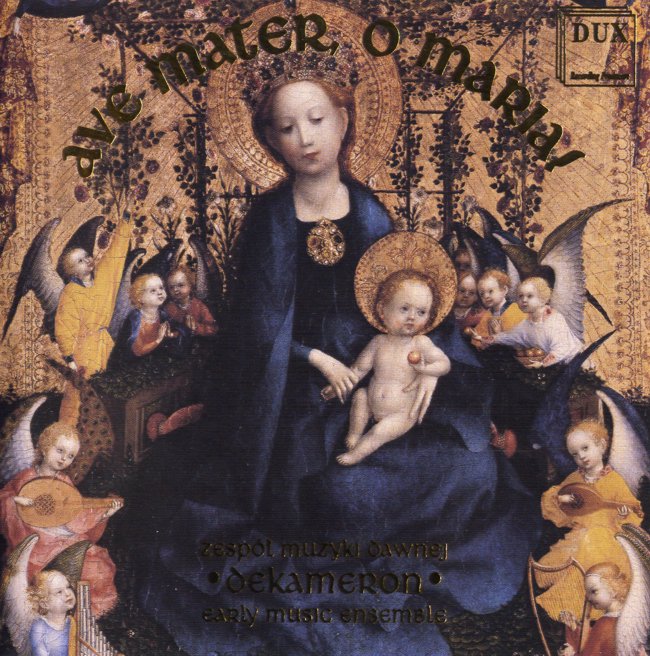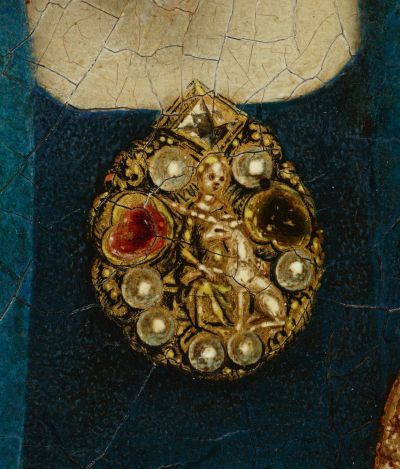Ave Mater, o Maria!, średniowiecne utwory marynje hiszpanii, francji, niemiec i polski
zespół muziki dawnej Dekameron early music ensemble

medieval.org
Dux 0129
2000
HISZPANIA · SPAIN · SPANIEN
ALFONSO EL SABIO (1223-1284). Cantigas de Santa Maria
1. Como Jesu Christo fezo a san Pedro [3:48]
CSM 369
sopran, fidel, tamburyn, chitarra morisca
2. Miragres fremosos [3:17]
CSM 37
sopran, fidel, darabuka, al oud
3. Todo logar mui ben pode sseer deffendudo [2:09]
CSM 28
fidel, bendir
4. Quen leixar Santa Maria por outra folia [3:19]
CSM 132
sopran, fidel, darabuka, al oud
5. Quen a Virgen ben servira [1:49]
CSM 103
sopran, fidel, bendir
FRANCJA · FRANCE · FRANKREICH
Motety · Motetes · Motetten
6. Aucun qui ne ~ Jure tuis laudibus ~ MARIA [2:19]
Kodeks Montpellier, XIII w. —
2 sopran, harfa
7. O Maria virgo Davitica ~ O Maria Maris Stella ~ VERITATEM [3:48]
Kodeks Montpellier, XIII w. —
2 sopran, harfa
8. O Maria Regine Glorie ~ Audi Pater ~ ALLELUYA [1:12]
Kodeks Bamberg, XIII w. —
2 sopran, harfa
NIEMCY · GERMANY · DEUTSCHLAND
Minnesäng
9. Salve Regina [4:12]
Reinmar von ZWETER, (ca. 1200-ca. 1260)
tenor, chrotta, rotta
10. Jesayas der Schrybet so [3:33]
FRAUENLOB, (1250-1318)
tenor, fidel, lutnia
11. Ich signe gerne [4:18]
NESTLER, XIII w.
tenor, chrotta
12. Maria, Muter [4:53]
Der MEISSNER, XVI w.
tenor, fidel, harfa
POLSKA · POLAND · POLEN
13. O gospodzie uwielbiona [1:45]
Rękopis Biblioteki Jagiellońskiej nr 2616 —
sopran, chór, 2 fidel, lutnia, harfa, symfonia
14. Virginem mire pulcritundis [2:24]
Rękopis Biblioteki Krasińskich, ca 1420 —
sopran, 2 fidel, lutnia
15. Ave Mater o Maria [1:43]
Rękopis Biblioteki Krasińskich, ca 1420 —
sopran, 2 fidel, lutnia
16. Ave Mater summi nati [3:14]
Rękopis Biblioteki Krasińskich, ca 1420 —
sopran, fidel, lutnia
17. Zdrowa bądź najświętsza królewno [6:10]
Rękopis praski, XV w. —
sopran, symfonia
18. Zdrowa bądź Maria [3:25]
Rękopis malborski, XV w.; Kancjonał Walentego z Brzozowa 1554 —
sopran, fidel, lutnia, harfa, symfonia
19. Ave hierarchia [1:12]
Graduał Tyniecki, 1526 —
sopran, psalterium
20. Bądź wiesiola Panno czysta [3:06]
Rękopis Biblioteki Raczyńskich, XV w. —
sopran, 2 fidel, lutnia
DEKAMERON, zespół muzika dawnej
Anna Mikołajczyk, sopran (1, 2, 4 - 8, 13 - 20)
Dorota Kozińska, sopran (6 - 8)
Jacek Wisłocki, tenor (9 - 13)
Małgorzata Feldgebel, fidel (1 - 5, 10, 12 -16, 18, 20); chrotta (9, 11)
Marzena Bajkowska, fidel (13 -15, 20)
Robert Siwak, tamburyn, tamburyn bearneński (1); bendir (3, 5); darabuka (2, 4);
Tadeusz Czechak, lutnia średniowieczna (10, 13 - 16, 18, 20); al oud (2, 4); chitarra morisca (1);
harfa (6 - 8, 12); rotta (9); symfonia (17); psalterium (19)
Gościnnie wystąpili / guest musicians:
Aldona Czechak, śpiew / vocal (13); symfonia (18)
Mirosław Feldgebel, śpiew / vocal (13); harfa (13, 18)
Małgorzata Polańska, symfonia (13)
Nagrania dokonano w
Kościół Wniebowzięcia Najświętszej Marii Panny w Warszawie w lisopadzie 1996r.
Recorded at the Assumption of the Virgin Mary Church un Warsaw, November 1996
Małgorzata Polańska, Lech Tołwiński: Reżyser nagrania /
Recording supervision & sound engineering
Krzysztof Gomoliński: Montaż cyfrowy / Digital editing
Antoni Dąbrowski, Anna Starowicz: Consultacja / Consultation
Stefan Lochner (1405/15-1451): Muttergottes in der Rosenlaube
Obraz na okładze. Własność / Cover. Courtesy of: Reinisches Bildarchiv, Köln
Piotr Konopka, Tomasz Sulejewski: Project graficzny, skład / Page layout & design
© DUX 2000
English liner notes

Kult Najświętszej Marii Panny towarzyszył cywilizacji chrześcijańskiej
od zarania, ale jego prawdziwy rozkwit w średniowiecznej Europie uważa
się za wynik działalności św. Bernarda, a potem św. Dominika. Począwszy
od XII stulecia stawiano ku czci Bożej Rodzicielki najokazalsze
świątynie, a wśród nich katedry Notre Dame w Paryżu, Chartres i Reims,
bazylikę opactwa benedyktyńskiego w Maria Laach, a także kościoły
Mariackie Krakowa, Torunia i Gdańska. W XIII wieku rozpoczął się wielki
ruch pielgrzymkowy do sanktuariów maryjnych w Montserat, Puy,
Rocamadour, Mariazell i do dziesiątków innych, rozsianych po calej
Europie miejsc, gdzie modlono się do cudownych obrazów i figur
Bogurodzicy. Madonna z Dzieciątkiem stanowiła ulubiony temat
średniowiecznej ikonografii. Początkowo przedstawiana była w pełnym
majestacie, najczęściej w otoczeniu wielbiących ją aniołów, lecz w miarę
upływu czasu jej wizerunki zaczęły tracić boskie dostojeństwo.
Zatroskana,
zamyślona bądź uśmiechnięta, emanująca ludzkim cieplem postać Matki
Boskiej, stała się szczególnie bliska ówczesnemu człowiekowi. Do Marii
zanoszono modlitwy o wyjednaniu u Boga najprzeróżniejszych łask, ku jej
chwale śpiewano pieśni, ona była bohaterką legend o cudownych
zdarzeniach. Do najpiękniejszych zbiorów poetycko-muzycznych opowieści
jej poświęconych, obok francuskich Miracles de Nostre-Dame Gautiera z Coincy z początków XIII wieku, należą kilkadziesiąt lat późniejsze kastylijskie Cantigas de Santa Maria.
Ich autorstwo przypisuje się królowi Alfonsowi X Mądremu, a wykonywane
byly przez śpiewaków oraz instrumentalistów licznie zatrudnionych na
dworze władcy. Cantigi, których treść nierzadko wywodziła się z ludowych
podań, traktowały min. o cudownych interwencjach Najświętszej Marii
Panny w sytuacjach beznadziejnych, a więc np. o tym, jak ratowała
złoczyńcę przed stryczkiem, uwiedzioną zakonnice przed hańbą,
zdesperowaną kobietę przed dzieciobójstwem... W owych opowieściach Matka
Boża zawsze okazywała miłosierdzie wobec grzeszników i pełną
wyrozumiałość dla ludzkich słabości.
We francuskiej twórczości
muzycznej XIII wieku wątek Maryjny pojawił się min. w motecie,
polifonicznej formie stanowiącej specjalność kompozytorów tego obszaru.
Każdy z głosów motetu opatrywano innymi słowami: tenor zazwyczaj
początkiem jakiegoś tekstu liturgicznego, natomiast pozostałe dwa glosy
albo tekstami zbliżonymi do siebie pod względem treści, albo też
zupełnie odmiennymi tak tematycznie, jak i językowo. Do utworów
pierwszego typu należy O Maria virgo Davitica / O Maria marls stella / Veritatem, gdzie zestawiono ze sobą dwa hymny pochwalne na cześć Matki Bożej. Przykładem drugiego rodzaju jest Aucun qui ne sevent / Jure tuis laudibus / Maria,
w którym łacińska poezja maryjna rozbrzmiewa jednocześnie z francuską
poezją miłosną. Owo Przenikanie się sfery sacrum i profanum wynika nie
tylko z wielotekstowością motetu, ale też z miejscowej tradycji
oddawania hołdu Najświętszej Marii Pannie. Trubadurzy i truwerzy
wysławiali ją niemal tymi samymi słowami, jakimi czcili damy swego
serca.
Francuska liryka posłużyła jako wzór minnesingerom, toteż
poczesna miejsce w ich twórczości zajmuje tematyka Maryjna. Niemieckie
pieśni ku czci Matki Bożej to nie tylko żarliwe modlitwy o osobistym
niemal charakterze, ale także swobodne adaptacje i parafrazy tekstów
liturgicznych. W Polsce utwory Maryjne - z Bogurodzicą na czele -
pojawiły się nieco później niż na zachodzie Europy i nie zawsze byly to
kompozycje oryginalne. Czasami zapożyczano je z repertuaru
"międzynarodowego", czego przykładem pochodząca z Włoch lauda Ave mater o Maria.
Powszechnie praktykowano przyswajanie kompozycji obcych poprzez
tłumaczenie ich łacińskich tekstów na język polski. Do takich przypadków
należy utwór Bądź wiesiola stanowiący rodzimą wersję
polifonicznego opracowania hymnu Gaude virgo. Niekiedy przekładowi
towarzyszyła jednak nowa melodia jak np. w pieśni O gospodzie uwielbiona, będąca translacją hymnu O gloriosa virginum.
Polski wkład do europejskiej spuścizny muzycznej stanowiły też
wielogłosowe opracowania popularnych śpiewów łacińskich, takich jak Ave hierarchia.
Muzyczna
podróż przez Europę ukazuje odmienność traktowania wątków Maryjnych
przez poszczególne nacje, ale jest także świadectwem uniwersalnej dla
średniowiecznych społeczeństw potrzeby wyrażania uwielbienia dla Bożej
Rodzicielki.
Agnieszka Leszczyńska
The
cult of the Blessed Virgin Mary has been part and parcel of Christian
civilization from its very birth. It began to flourish in medieval
Europe as the result of the activities of St. Bernard and, subsequently,
St. Dominic. From the 12th century onwards some of the most splendid
churches were built in praise of the Mother of God, including the
Cathedrals in Paris (Notre Dame), Chartres and Rheims, the Benedictine
Abbey in Maria Laach near Coblenz, as well as St. Mary's Churches in
Kraków, Toruń and Gdańsk. The 13th century saw the beginning of the
wideranging practice of pilgrimages to the Marian sanctuaries in
Montserrat, Puy, Rocamadour, Mariazell and dozens of other places across
Europe where prayers were said in front of the miraculous images and
figures of the Mother of God. The Madonna with Child was one of the
favourite subjects of medieval iconography. Initially she was presented
in full splendour, usually surrounded by angels in adoration. With the
passing of time, the images of the Madonna began to lose their divine
majesty.
The grieving, smiling or pensive Mother of God, now
emanating human warmth, became particularly close to man. People prayed
to Our Lady to intercede with God in granting them the required graces.
Songs were written extolling her glory. She was the heroine of numerous
legends about miraculous events. Among the most beautiful collections of
poetic and musical tales devoted to the Mother of God are the French Miracles de Nostre-Dame by Gautier of Coincy from the beginning of the 13th century and the Castillian Cantigas de Santa Maria.
The latter collection is said to have been compiled by Alfonso the
Wise, the King of Spain, around 1280. These religious songs were
performed by the sizeable complement of singers and instrumentalists
employed at the royal court. Many of the songs had a folk provenance and
spoke of the miraculous interventions of the Blessed Virgin Mary in
hopeless situations. And so, thanks to the Mother of God, a criminal was
spared imminent death at the gallows, a seduced nun did not fall from
grace and a despairing mother did not commit childmurder. In all the
songs, Our Lady showed mercy towards sinners and full understanding for
human weaknesses.
In the French music of the 13th century, the
Marian strand appeared, among other things, in the motet, the polyphonic
form in which French composers excelled. Each of the motet's voices was
assigned different words, the tenor usually sang the beginning of a
liturgical text whereas the remaining two voices were set to texts
either very similar or vastly different in content. O Maria virgo Davitica / O Maria mans stells/ Veritatem, in which two laudatory hymns in praise of the Mother of God are put side by side, belongs to the former type. Aucun qui ne sevent / Jure tuis laudibus / Maria,
in which Latin Marian poetry is put side by side with French love
poetry, is an example of the latter. The intertwining of the sacred and
the profane is also linked to the local tradition of paying homage to
the Blessed Virgin Mary. The troubadours and minstrels extolled her
virtues using almost the same words in which they addressed the ladies
of their heart. French lyric poetry served as a model for the
minnesingets, hence the Marian theme occupied an important place in
their work. German songs in praise of the Mother of God are not only
fervent prayers of a very intimate, personal character but also free
adaptations and paraphrases of liturgical texts.
In Poland, Marian songs, the best known of which was Bogurodzica
("Mother of God"), appeared a bit later than in Western Europe. Many of
them were Polish versions of songs from other nations, if only to
mention Ave mater o Maria imported from Italy. The adoption of foreign works by translating their Latin texts into Polish was common practice. Badź wiesiola (Rejoice Virgin), for instance, is the Polish polyphonic setting of the hymn Gaude virgo. In some cases, however, a Polish translation was assigned a new melody, as in the song O gospodzie uwielbiona (Glory to Thee) which was the Polish answer to the hymn O gloriosa virginum. The Polish contribution to European musical heritage also comprised polyphonic arrangements of popular Latin songs, such as Ave hierarchia.
This
musical journey through Europe demonstrates the diversity in the
treatment of Marian themes by various nations. It also vividly shows
that the expression of praise to the Mother of God was universal in
medieval societies.
Agnieszka Leszczynska
Translation: Michal Kubicki



